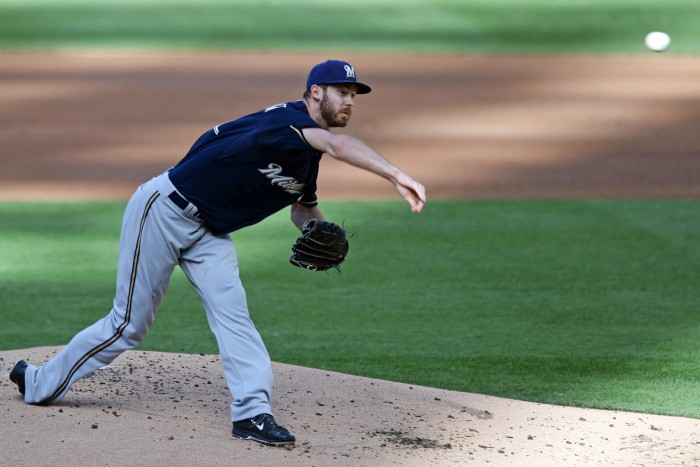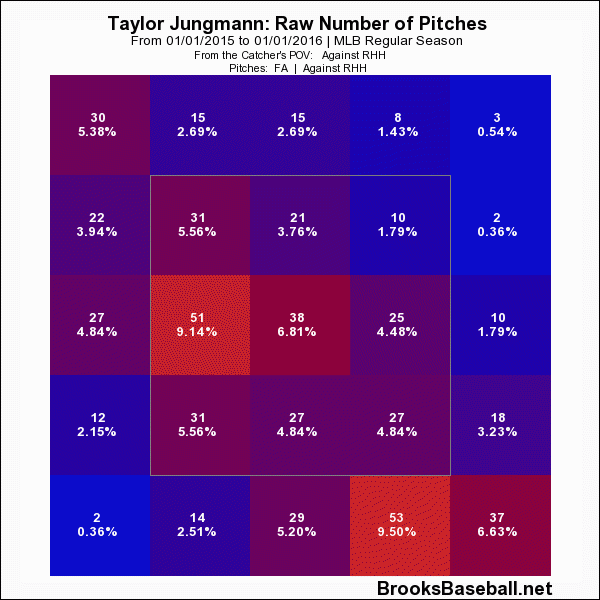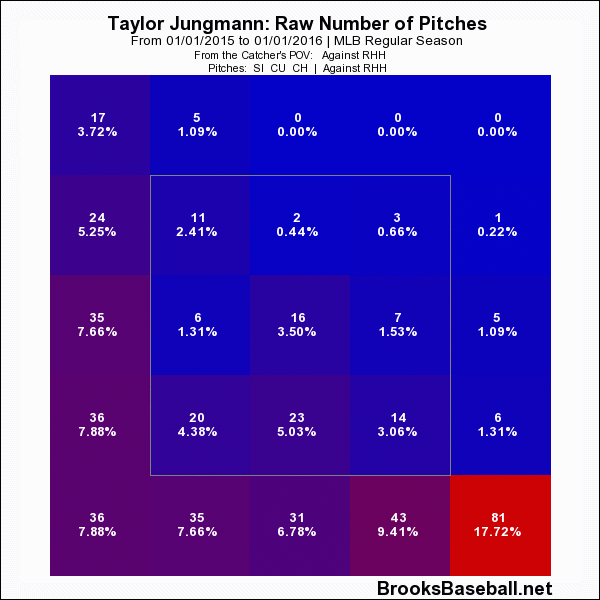With all of the cringe- (and other bodily function) inducing pitching performances that the 2015 Brewers produced, right-hander Taylor Jungmann really stood alone. His ERA ranked first among the team’s starters, and so did his DRA. Over his 21 starts and 119.1 innings pitched, he provided Brewers fans with a safe haven from the putrid play of his colleagues.
Presumably, those same fans would like Jungmann to keep this up. While they certainly appreciated everything he did for the club this season, it ultimately didn’t count for anything — whereas in 2016 and the years that will follow it, Milwaukee might actually need a hurler to lead its rotation. Will Jungmann repeat his 2015 campaign, or will he regress to the mediocrity that most scouts foresaw from him as a farmhand? The answer to that may hinge upon his ability to pitch indiscriminately, which is where our fascinating tale begins.
As my boss J.P. Breen noted earlier this year, Jungmann had a reverse platoon split in the minors:
| Handed | BA | OBP | SLG | OPS |
|---|---|---|---|---|
| R | .250 | .329 | .381 | .710 |
| L | .250 | .337 | .342 | .680 |
Strangely, despite throwing with his right hand, Jungmann continually found more success against left-handed batters. And even more strangely, he did the exact opposite upon arriving at the show:
| Handed | AVG | OBP | SLG | wOBA |
|---|---|---|---|---|
| R | .220 | .305 | .383 | .688 |
| L | .257 | .342 | .377 | .719 |
In 2015, the average right-handed pitcher tallied a .701 OPS against righties (which Jungmann beat by four percent) and a .747 OPS against lefties (which he beat by two percent). In other words, Jungmann had no platoon split in his major-league debut. So which version is the real one?
Let’s first examine Jungmann’s minor-league splits by batter handedness, which have an unusual breakdown:
| Handed | K% | BB% | ISO | BABIP |
|---|---|---|---|---|
| R | 19.1% | 7.9% | .131 | .293 |
| L | 17.4% | 11.7% | .092 | .298 |
He struck out more right-handed batters, walked fewer, and allowed hits on balls in play at the same clip as he did to left-handed batters. The only real difference came in terms of power (and hit-by-pitches, which I’ll discuss next week). As a major leaguer, Jungmann saw three of those trends remain steady, while one went crazy:
| Handed | K% | BB% | BABIP | ISO |
|---|---|---|---|---|
| R | 22.3% | 8.1% | .259 | .163 |
| L | 20.3% | 10.8% | .321 | .120 |
The K, BB, and ISO disparities didn’t shift, but the BABIP commonality evaporated. Jungmann simultaneously cut down on hits versus righties and gave up far more versus lefties. This combination granted him the power to retire everyone who batted against him, which played a large role in his splendid season.
On a pitch-by-pitch basis, we can spot a clear outlier. Jungmann’s sinker, curveball, and changeup — i.e., his three secondary offerings — each posted a marginally higher BABIP when thrown to righties. The gap came from his primary pitch: Jungmann’s four-seam fastball went for a hit 25.0 percent of the time a right-handed batter put it in play and 37.7 percent of the time a left-handed batter did so. The heater, which comprised 55.3 percent of his pitches this year (about the same for everyone), made all the difference.
Based on his heatmap, Jungmann didn’t seem to make any massive changes in four-seam location based on the handedness of the batter:
Against all opponents, Jungmann threw his fastball mostly toward the middle-ish of the plate, occasionally going to the upper left and the lower right. Given this, we might conclude that the dropoff in BABIP was just a fluke.
Here’s the thing, though: Those pitches looked different to different batters. According to the theory of effective velocity, pitches up and in appear faster, while pitches down and away appear slower. Since greater velocity obviously works in the pitcher’s favor, this means it behooves him to (within reason) target the former area. When Jungmann threw his four-seamer to a same-handed batter, it would tail up toward them, where they wouldn’t be able to make good contact. The lefties got pitches to the same height, but outside more, where they could handle it better.
Think of it this way. Jungmann located his secondary pitches thusly based on handedness:
Here, we see a clear shift to a down-and-away approach for everyone (which may reflect team policy). And, as mentioned above, these offerings didn’t differ in BABIP here either. Because Jungmann threw his four-seam fastball in a more even manner, he put up a sizable BABIP difference, one that played an integral role in eliminating his platoon split.
We can’t really know how this differs from what Jungmann did in the minors, since comprehensive PITCHf/x data for his time there doesn’t exist. Further, BABIP — as you know by now — can fluctuate a lot without reflecting a true change in skill. We should therefore expect the left-right ball-in-play gap Jungmann displayed this year to regress somewhat going forward, which means his reverse platoon split may return.
With that said, the fact that his underlying process supports this means the 2015 results could stick around. And, for what it’s worth, his batted-ball profile backs up the split — righties had a 25.3 percent hard-hit rate and a 23.0 percent soft-hit rate off him, compared to a respective 29.7 and 15.8 percent for lefties. Overall, it certainly seems that Jungmann can sustain this, pairing solid strikeout and walk marks against right-handed batters with a low BABIP.
In all likelihood, the phenom that was early-2015 Taylor Jungmann will never resurface. He still has mediocre command and poor mechanics to boot. That doesn’t mean that Jungmann can’t continue to prosper at the major-league level, or that he’ll stop giving the Milwaukee faithful a reason to cheer.



1 comment on “Does Taylor Jungmann Have A Platoon Split?”